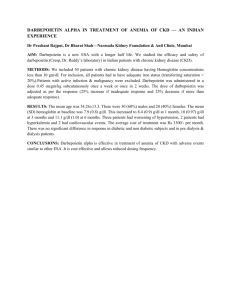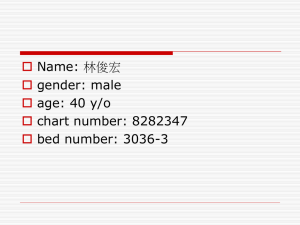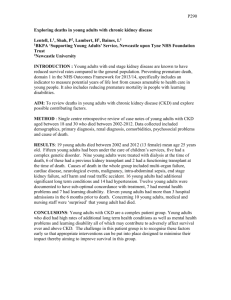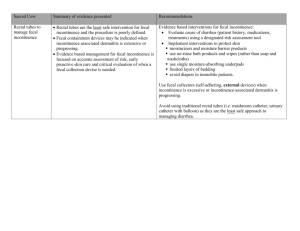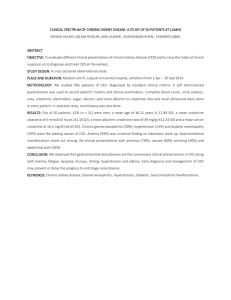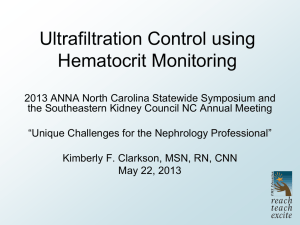View/Open
advertisement
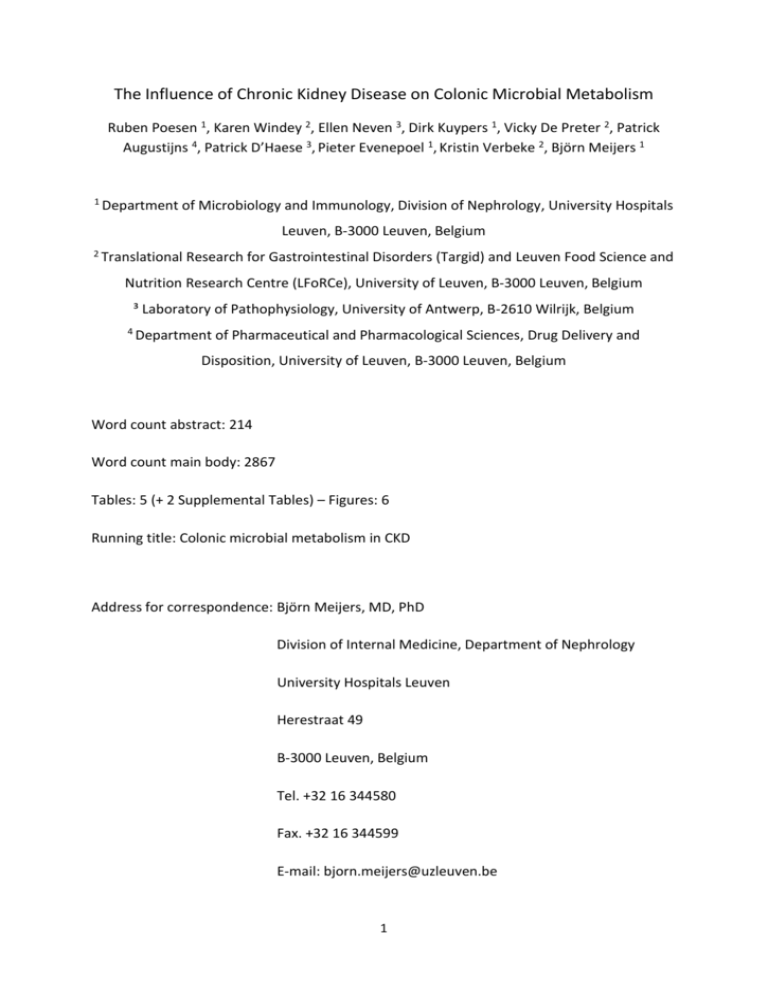
The Influence of Chronic Kidney Disease on Colonic Microbial Metabolism Ruben Poesen 1, Karen Windey 2, Ellen Neven 3, Dirk Kuypers 1, Vicky De Preter 2, Patrick Augustijns 4, Patrick D’Haese 3, Pieter Evenepoel 1, Kristin Verbeke 2, Björn Meijers 1 1 Department of Microbiology and Immunology, Division of Nephrology, University Hospitals Leuven, B-3000 Leuven, Belgium 2 Translational Research for Gastrointestinal Disorders (Targid) and Leuven Food Science and Nutrition Research Centre (LFoRCe), University of Leuven, B-3000 Leuven, Belgium ³ Laboratory of Pathophysiology, University of Antwerp, B-2610 Wilrijk, Belgium 4 Department of Pharmaceutical and Pharmacological Sciences, Drug Delivery and Disposition, University of Leuven, B-3000 Leuven, Belgium Word count abstract: 214 Word count main body: 2867 Tables: 5 (+ 2 Supplemental Tables) – Figures: 6 Running title: Colonic microbial metabolism in CKD Address for correspondence: Björn Meijers, MD, PhD Division of Internal Medicine, Department of Nephrology University Hospitals Leuven Herestraat 49 B-3000 Leuven, Belgium Tel. +32 16 344580 Fax. +32 16 344599 E-mail: bjorn.meijers@uzleuven.be 1 Abstract There is an increasing interest in the colonic microbiota as a relevant source of uremic retention solutes accumulating in chronic kidney disease (CKD). Renal disease can also profoundly affect the colonic micro-environment and has been associated with a distinct colonic microbial composition. However, the influence of CKD on the colonic microbial metabolism is largely unknown. Therefore, we studied fecal metabolite profiles of hemodialysis patients and healthy controls using a gas chromatography mass spectrometry method. We observed a clear discrimination between both groups with 81 fecal volatile organic compounds being significantly different between hemodialysis patients and healthy controls. To further explore the differential impact of renal function loss per se versus dietary and other CKD-related factors, we also compared fecal metabolite profiles between hemodialysis patients and household contacts on the same diet, demonstrating a close resemblance. On the other hand, significant differences could be noted between fecal samples of rats 6 weeks after 5/6th nephrectomy and those of sham-operated rats, still suggesting an independent influence of renal function loss. Thus, CKD is associated with a distinct colonic microbial metabolism, although the impact of renal function loss per se in humans may be inferior to dietary and other CKD-related factors. The potential beneficial effect of therapeutics targeting colonic microbiota in CKD patients has to be awaited. 2 Background The human intestinal tract is colonized by hundreds of trillions of microbes, collectively possessing hundreds of times as many genes as coded for by the human genome. The combined genetic potential of the endogenous microbiota, referred to as the ‘microbiome’, supplements the host with trophic, metabolic and protective signals.1 Accordingly, the mammalian plasma metabolome is a composite of endogenous metabolites and metabolites originating from the colonic microbiota.2 The colonic microbiota is also a significant contributor to the metabolome in patients with chronic kidney disease (CKD).3 Widely studied uremic retention solutes as p-cresyl sulfate and indoxyl sulfate are actually microbiome-human co-metabolites. p-Cresyl sulfate results from the combined actions of bacterial fermentation of tyrosine to p-cresol and endogenous sulfate conjugation. Likewise, indoxyl sulfate is the end-product of bacterial fermentation of tryptophan to indole followed by endogenous oxidation and sulfate conjugation.4;5 Loss of renal function leads to retention of these solutes.6;7 Notably, renal function is not the sole determinant of serum concentrations of these colon-derived uremic retention solutes. In a recent study, both eGFR and intestinal generation independently determined serum concentrations of p-cresyl sulfate and indoxyl sulfate, with intestinal generation showing substantial inter-individual variability.8 This interplay between intestinal generation and renal excretion has been coined the gut-kidney axis.9 Vaziri et al, in a pivotal study, already demonstrated that the colonic microbial composition itself is altered in CKD. Notable increases in the number of bacterial operational taxonomic 3 units belonging to the Brachybacterium, Catenibacterium, Enterobacteriaceae, Halomonadaceae, Moraxellaceae, Nesterenkonia, Polyangiaceae, Pseudomonadaceae and Thiothrix families were found.10 To isolate the effect of renal function loss from CKD-related dietary restrictions, drug therapy and co-morbid conditions (e.g., diabetes mellitus), they additionally used a 5/6th nephrectomy rat model, again observing significant differences in the colonic microbial composition. As different microbial species can share similar functional gene profiles, so-called functional redundancy, knowledge of the microbial composition alone does not necessarily lead to an understanding of its metabolic activity.11 Moreover, the colonic microbial composition is not the sole determinant of the microbial metabolism. Apart from the microbial composition, physico-chemical characteristics of the fermentable substrate, amount of substrate available, intraluminal pH, colonic transit time and other factors all affect the way substrates are utilized and fermentation products are formed.12-14 It must be noted that CKD profoundly affects the gastro-intestinal environment, thereby potentially influencing colonic microbial metabolism. We previously demonstrated that small intestinal protein assimilation is disturbed in CKD patients.15 In addition, intraluminal pH is higher due to a higher ammonia concentration. Also, colonic transit time is prolonged.16 Furthermore, patients with renal dysfunction also receive intestinal targeted drug therapy (e.g., phosphate binders), as well as dietary restrictions, mostly fruit and vegetables, which prevent potassium overload, but as a trade-off result in a significantly decreased fiber intake.17 Therefore, we questioned whether the colonic microbial metabolism is CKD-specific. As CKD extends beyond renal function loss, with associated differences in diet, age, drug therapy, 4 and co-morbidity, the second aim was to disentangle the effect of renal function loss per se versus the overall impact of CKD (‘renal phenotype’). Results Baseline characteristics of hemodialysis patients and control groups We included 20 maintenance hemodialysis patients with a median age of 74 years (interquartile range (IQR) 64 – 81) and a dialysis vintage of 22 months (IQR 9 – 30). All patients were on a stable hemodialysis regime (4 hours, 3 times weekly) with a mean singlepool Kt/V of 1.77 (Standard deviation (SD) 0.25) reflecting adequate dialysis treatment. Most of the hemodialysis patients (70 %) were treated with phosphate binders and all patients received nutritional counseling to restrict dietary intake of fluid, sodium, phosphate and potassium. Baseline characteristics of the hemodialysis group and 3 control groups (i.e., unrelated healthy subjects, unrelated age-matched healthy subjects and household contacts on the same diet) are summarized in table 1. CKD versus healthy controls We measured fecal metabolite profiles of hemodialysis patients and healthy controls using a previously reported gas chromatography mass spectrometry (GC-MS) method.18 This technique allows for untargeted metabolomics of fecal volatile organic compounds (VOCs). In total, we identified 243 different VOCs. Of these, 48 VOCs were subject-specific and 25 VOCs were found in all subjects. In addition, there was a significantly higher number of VOCs per sample in healthy controls compared to hemodialysis patients (mean of 98 (SD 8) vs. 79 (SD 5) VOCs, respectively, P < 0.0001). At first, data were analyzed by principal component analysis (PCA) and hierarchical cluster analysis, both unsupervised methods, already 5 demonstrating substantial differences between fecal metabolite profiles of hemodialysis patients and healthy controls (Figure 1). Next, we built a partial least square discriminant analysis (PLS-DA) model to optimize differences between these 2 groups, resulting in a clear discrimination between hemodialysis patients and controls (Figure 2A). This PLS-DA model was further validated using leave-one-out cross-validation. As can be observed in figure 2B, all samples could precisely be allocated to one of both groups. As a final validation step, we included 5 unrelated fecal samples of hemodialysis patients, allowing us to perform a prediction analysis for these 5 samples (Figure 2B). Again, each sample could accurately be classified as belonging to the group of hemodialysis patients, demonstrating stability and predictive performance of the obtained model. We then explored individual VOCs responsible for discrimination of fecal metabolite profiles. After adjustment for the false discovery rate (FDR), we identified a total of 81 individual VOCs being significantly different between hemodialysis patients and healthy controls. Of these, 53 VOCs were upregulated and 28 VOCs were downregulated in hemodialysis patients (Table 2 and 3). As can be derived from table 2, both p-cresol and indole were also upregulated in the hemodialysis group. When grouping individual metabolites according to chemical classes with inspection of the correlation loading plot, we observed an upregulation of aldehydes, benzenes, branched-chain fatty acids, furans, indoles, mediumchain fatty acids and short-chain fatty acids, while ketones were downregulated in hemodialysis patients. As there were significant differences in baseline characteristics between hemodialysis patients and healthy controls, potentially contributing to the observed discrimination of 6 fecal metabolite profiles, we included a second healthy control group with a similar age, gender and body mass index distribution. As demonstrated in figure 3A, a pronounced discrimination between fecal metabolite profiles of hemodialysis patients and the second healthy control group was noted in the corresponding PLS-DA model. In addition, each leftout sample and each sample of the 5 unrelated hemodialysis patients could accurately be classified in leave-one-out cross-validation and prediction analysis, respectively (Figure 3B). The same was also observed when performing a secondary analysis in non-diabetic hemodialysis patients (Figure 3C and 3D). When investigating discriminating metabolites, we identified a total of 55 significant VOCs (FDR-adjusted) of which 17 VOCs were also different between hemodialysis patients and the other healthy control group (Supplemental Table 1 and 2). CKD versus household contacts on the same diet As CKD patients are subjected to substantial dietary restrictions and other therapeutic interventions, it is difficult to elucidate the impact of renal function loss per se on the colonic microbial metabolism. Therefore, we included a second control group of household contacts sharing the dietary habits of the hemodialysis patients. In addition, there were neither significant between-group differences in age, gender, body mass index nor in the prevalence of diabetes. In this population, we identified a total of 203 different VOCs with 53 subjectspecific VOCs and 28 VOCs that were found in all subjects. There was no significant difference in number of VOCs per sample between hemodialysis patients and household contacts on the same diet (mean of 79 (SD 5) vs. 77 (SD 9) VOCs, respectively, P 0.38). When performing PCA on fecal metabolite profiles of both groups, there was no discrimination between samples of hemodialysis patients and household contacts (data not shown). By 7 assigning group information with the PLS-DA model (Figure 4A), a discrimination could be observed between the 2 groups, which was, however, not as pronounced as in the previous analysis. Classification of left-out samples in the leave-one-out cross-validation was also inaccurate (sensitivity 45 % - specificity 50 %) and prediction analysis of unrelated hemodialysis patients failed to correctly predict 3 out of 5 samples (Figure 4B). Again, we explored individual VOCs being different between hemodialysis patients and household contacts on the same diet. Now, we only identified 2 VOCs (benzofuran and dimethyl sulfide), albeit not formally significant after FDR adjustment. When taking into account chemical classes and examining the correlation loading plot for possible shifts, we found an upregulation of aldehydes and furans in the group of hemodialysis patients. The differential impact of the renal phenotype (including differences in diet, age and other CKD-related factors) versus renal function loss itself was also clearly visualized in the score plot of the combined PLS-DA model, simultaneously incorporating all 4 groups (hemodialysis patients, healthy subjects, age-matched healthy subjects, household contacts on the same diet) (Figure 5). While there was a clear discrimination between fecal metabolite profiles of hemodialysis patients and both healthy control groups, this difference faded when considering household contacts on the same diet. Animal data To further explore the sole impact of renal function loss we compared CKD rats 6 weeks after induction of 5/6th nephrectomy with control rats 6 weeks after sham operation. As expected, serum creatinine and 24h proteinuria were significantly higher in the CKD group 8 than in the control group. Although both groups gained weight during study, final body weight of CKD rats was lower, probably due to a lower cumulative food intake (Table 4). When analyzing their fecal metabolite profiles, we observed a total of 227 individual VOCs. Of these, 20 VOCs were animal-specific and 60 VOCs were found in all fecal samples. There were no significant differences in number of VOCs per sample between fecal samples of CKD rats and those of control rats (mean of 136 (SD 7) vs. 133 (SD 6) VOCs, respectively, P 0.36). PCA demonstrated discrimination between fecal samples of both groups (data not shown), which was even more pronounced when also including group information within the PLS-DA model (Figure 6A). In leave-one-out cross-validation, apart from one sample in each group, all samples could be correctly classified (sensitivity of 90 % and specificity of 90 %) (Figure 6B). We also explored individual metabolites responsible for the discrimination. In unadjusted analysis, 58 VOCs differed between CKD rats and control rats. After FDR adjustment, 4 VOCs remained significantly different (Table 5). Of these, levels of ethylbenzene were downregulated in CKD rats, in agreement with the hemodialysis patients. For p-cresol and indole, there were no significant differences between CKD and control rats (both unadjusted P-value of 0.10). When stratified according to chemical classes in the correlation loading plot, induction of renal insufficiency by 5/6th nephrectomy resulted in a predominant upregulation of alkanes, branched-chain fatty acids, phenols and sulfides, while short-chain fatty acids and esters were downregulated. Discussion 9 In this study we explored the influence of CKD on the colonic microbial metabolism. The key findings are that CKD is associated with a distinct colonic microbial metabolism. The CKDrelated differences in the human colonic microbial metabolism can be attributed to a large extent to dietary restrictions and to a lesser extent to loss of renal function. Lately, there is increasing interest in the colonic microbial metabolism as contributor to uremic retention solutes accumulating in CKD.4;5 Both p-cresyl sulfate and indoxyl sulfate are representatives of this group of solutes and have been associated with overall mortality, cardiovascular disease and progression of CKD.6;7;19-22 Recently, it has been demonstrated that CKD profoundly alters the colonic microbial composition.10 However, the impact of CKD on the colonic microbial metabolism is largely unexplored. In a first analysis, we demonstrated substantial differences in fecal metabolite profiles of hemodialysis patients and healthy controls, indicative of a distinct colonic microbial metabolism in CKD. When looking into more detail, we identified a total of 81 fecal metabolites being significantly different between hemodialysis patients and healthy controls. Interestingly, generation of both p-cresol and indole as precursors of p-cresyl sulfate and indoxyl sulfate, respectively, was also upregulated in hemodialysis patients, which confirms and extends a previous observation of higher levels of p-cresol and indole producing microbiota in patients with CKD.23 In addition, there was an overall upregulation of aldehydes, benzenes, branched-chain fatty acids, furans, indoles, medium-chain fatty acids and short-chain fatty acids, while generation of ketones was blunted in hemodialysis patients. The clinical relevance of these fecal metabolite shifts is unknown. It may be hypothesized that alterations in fecal metabolite profiles may contribute to CKD-associated 10 intestinal barrier dysfunction, possibly leading to bacterial translocation and endotoxemia as a mechanism behind systemic inflammation and cardiovascular disease in CKD patients.24-26 In addition, this may cause a paradigm shift in the traditional view of CKD as a state of accumulating, potentially toxic, solutes due to diminished renal excretion. Indeed, these findings may suggest that CKD also affects the intestinal exposure to different metabolites. Linking these fecal metabolite shifts to concomitant changes in serum levels in CKD patients may therefore be relevant to further elucidate the importance of the gut-kidney axis. As CKD not only implies a loss of renal function, but goes along with differences in age and co-morbidity (e.g., diabetes mellitus), as well as substantial restrictions in diet, we performed additional analyses in an attempt to elucidate the differential impact of renal function loss itself versus the renal phenotype. First, we included an age-matched healthy control group, again demonstrating a pronounced discrimination with hemodialysis patients. Next, we compared hemodialysis patients with household contacts on the same diet that were also similar with respect to age, gender, body mass index and presence of diabetes mellitus. Fecal metabolite profiles of household contacts closely resembled those of hemodialysis patients. As the household contacts were no direct relatives of the hemodialysis patients, a common genetic background cannot explain the resemblance in fecal metabolite profiles, thus pointing to similarity in external influences. In this regard, it has been noted that cohabitation is associated with a more comparable colonic microbial composition27;28. Although this has mainly been explained by shared dietary habits as also present in the household contacts of our study, there may also be possible involvement of the mutual physical environment and social interaction.29;30 Additionally, as it remains challenging to explore the sole effect of human renal function loss, we studied fecal 11 metabolite profiles in rats 6 weeks after 5/6th nephrectomy as well as after sham operation with both groups receiving regular dietary supply. In agreement with a previous experimental study by Meinardi et al.,31 there were substantial differences in fecal metabolite profiles between CKD and control rats, pointing to an important and independent influence of renal function loss per se. Although inter-species differences cannot be excluded, these findings suggest that dietary and other CKD-related factors have a substantial impact on colonic microbial metabolism in CKD patients and may even outweigh the impact of renal function loss itself. As nutrient intake is one of the most important factors driving colonic microbial behavior in the general population, it may not be surprising that dietary differences have a substantial impact on colonic microbial metabolism in CKD patients.13;32 However, changing nutrient intake in CKD patients may not be simple, as these patients are at risk for hyperkalemia, hyperphosphatemia and malnutrition. Therefore, targeting the colonic microbial metabolism may be more feasible than interfering with current standard-of-care dietary restrictions. We previously explored the potential beneficial effect of prebiotics consisting of a mixture of inulin and oligofructose in hemodialysis patients, resulting in reduced serum levels and generation rates of p-cresyl sulfate.33 Small studies with probiotics also demonstrated their potential to reduce generation of certain microbial-derived uremic retention solutes (e.g., indoxyl sulfate).34;35 However, it must be noted that, although these results are encouraging, there are no studies investigating the benefit of these therapeutics on hard clinical endpoints. 12 There are limitations to our study. First, to investigate colonic microbial metabolism we studied metabolite profiles in fecal samples, probably more reflecting distal colonic microbial metabolism than that of the entire colon. In addition, we cannot exclude a concomitant effect of altered colonic metabolite transport due to CKD. Third, although household contacts were selected based on a statement of similar dietary habits, we did not formally include dietary assessments. Minor dietary differences between hemodialysis patients and household contacts can therefore not be excluded, but would probably not substantially alter the abovementioned conclusions. Availability of dietary information may also have enabled us to link changes in fecal metabolite profiles to specific CKD-related dietary differences. Fourth, our study population mainly consisted of patients of Caucasian origin. Care must be taken to extrapolate our data to other patient populations. Finally, a direct comparison between animal and human data may be challenging when considering interspecies differences in colonic microbial metabolism. Thus, further studies are still required to establish the sole effect of human renal function loss on fecal metabolite profiles. In conclusion, the colonic microbial metabolism is altered in CKD. While this can be attributed in part to loss of kidney function per se, dietary and other CKD-related factors also affect the colonic microbial metabolism and even outweigh the importance of a reduced glomerular filtration rate. These observations challenge the conventional paradigm of accumulation of potentially toxic solutes solely due to diminished renal excretion. Our findings suggest that CKD also affects exposure to metabolites through altered colonic microbial metabolism. Concise methods 13 Patients and controls CKD patients, treated with maintenance hemodialysis therapy for at least 3 months at the dialysis unit of the University Hospitals Leuven, 18 years or older and able to provide consent, were eligible for inclusion (clinicaltrials.gov NCT01874210). We included 3 control groups composed of unrelated healthy subjects, unrelated age-matched healthy subjects, as well as household contacts on the same diet. Each group consisted of 20 subjects. Patients with known gastro-intestinal disease (e.g., inflammatory bowel disease) and previous colorectal surgery were excluded. Use of antibiotics, prebiotics or probiotics in the past 4 weeks was not allowed. Both hemodialysis patients and control subjects were asked to bring a fecal sample to the laboratory within 12 hours of defecation. After collection of the fecal sample, an aliquot was immediately frozen and stored at – 20 °C until further analysis. Preliminary testing demonstrated no differences between fecal metabolite profiles of fresh and frozen (– 20 °C) samples. The study was performed according to the Declaration of Helsinki and approved by the ethics committee of the University Hospitals Leuven. Informed consent was obtained from all patients. Animals Experimental procedures were conducted according to the National Institutes of Health Guide for the Care and Use of Laboratory Animals 85-23 (1996) and approved by the ethics committee of the University of Antwerp (Permit number: 2012-13). Fourteen male Wistar rats (Charles River, Lille, France) were subjected to 5/6th nephrectomy, consisting of the ligation of 2/3 of the extrarenal branches of the renal artery of the left kidney, followed by nephrectomy of the right kidney one week later. Before surgery, rats were anesthetized by intraperitoneal injection of 60 mg/kg Nembutal (Ceva Santé Animale, Libourne, France). 14 During study, rats were fed a standard rodent diet (SSNIFF Spezialdiäten, Soest, Germany) and had free access to food and water. Animals were housed 2 per cage and bedding was changed twice weekly. At 6 weeks post 5/6th nephrectomy, 10 animals were still alive and included for further analysis. At that moment, blood was drawn by puncture of the tail vein. Furthermore, urine and fecal matter were collected for 24 hours using metabolic cages. As a control group, we used 10 male Wistar rats undergoing sham operation and fed the same diet. Again, 6 weeks after the procedure, collection of blood, urine and fecal matter was performed. Analytical methods Fecal metabolite profiles were studied using a dedicated GC-MS method, allowing for untargeted metabolomics of fecal VOCs with identification of a highly relevant subgroup, including p-cresol and indole as precursors of p-cresyl sulfate and indoxyl sulfate, respectively 18. Immediately before analysis, fecal aliquots were thawed and 0.25 g fecal sample was suspended in 4870 µl water. 2-Ethylbutyrate (40 µl; 250 mg/100 ml) was added as internal standard. A magnetic stirrer, a pinch of sodium sulfate, and 130 µl sulfuric acid were added to the sample to salt out and acidify the solution, respectively. To prevent crossover from one sample to another, water samples were extracted after each sample. The VOCs were analyzed on a GC-MS (Trace GC, Thermoquest, Rodano, Italy and DSQ II, Thermo Electron, San José, CA, USA), which was coupled on-line to a purge-and-trap system (Velocity, Teledyne Tekmar, Mason, OH, USA). Metabolites were purged out the sample for 20 min with a helium flow rate of 40 ml/min, carried over a dry flow column (Trap Tenax tbv Velocity, Interscience, Louvain-la-Neuve, Belgium) for 3 min to control moisture transfer, and concentrated on a second polar trap column (Trap Vocarb tbv Velocity, Interscience). 15 Consequently, the VOCs were desorbed from the trap by raising the trap temperature to 250 °C for 5 min. After desorption, the trap temperature was further raised to 270 °C for 10 min to remove any contamination of tailing compounds. The desorbed compounds were conducted via the transfer line (175 °C) to the injector of the GC, where they were separated on an analytical column, AT Aquawax DA (30 m x 0.25 mm internal diameter, 0.25 µm film thickness, Grace, Deerfield, IL, USA). Helium was used as carrier gas with a constant flow of 10 ml/min. The oven temperature was maintained at 35 °C (isothermal for 2 min) and increased with 5 °C/min to 100 °C and with 10° C/min to 240 °C. This final temperature was held for 5 min. MS was performed in full scan mode from m/z 30 to m/z 500 at 2 scans/s. Xcalibur software (Thermo Scientific, Breda, The Netherlands) was used for the automatization of the GC-MS and for data acquisition. The resulting chromatograms were processed using Automatic Mass Spectral Deconvolution and Identification Software (AMDIS, version 2.71) provided by the National Institute of Standards and Technology (NIST, Gaithersburg, MD, USA). Identification of the metabolites in the samples was achieved by comparing the mass spectra of unknown peaks with the NIST library. Compounds showing mass spectra with match factors ≥ 90 % were positively identified. Differential peak identities were further confirmed for retention time and mass spectra from our in-house standards library. All compounds were relatively quantified compared with 2-ethylbutyrate. Statistical analysis Data are expressed as mean (standard deviation (SD)) for normally distributed variables or median (interquartile range (IQR)) for non-normally distributed variables. Between-group differences of baseline characteristics were tested using Student's t-test, Wilcoxon rank sum test or Chi-squared test, as appropriate. P-values less than 0.05 were considered significant. 16 For statistical processing of fecal metabolite profiles, sample-specific VOCs, i.e., compounds that were detected in only one subject, were discarded from statistical analysis because they do not exert any discriminatory power due to their low occurrence rate and introduce noise if implemented into the classification model 36. Multivariate statistical analysis consisted of principal component analysis (PCA), hierarchical cluster analysis and partial least square discriminant analysis (PLS-DA). Data were weighed by their standard deviation to give them equal variances. PCA and hierarchical cluster analysis, both unsupervised methods, were carried out for first data exploration and clustering of metabolite profiles without knowledge of group membership. PLS-DA, a supervised learning technique, was then applied to cluster samples with similar metabolite profiles after assignment of group information. The obtained models were validated using leave-one-out cross-validation and additional inclusion of 5 unrelated samples of hemodialysis patients also allowed to test the predictive performance of these models. Between-group differences of VOCs were explored with the correlation loading plot and Wilcoxon rank sum test. The Benjamini – Hochberg false FDR was applied to correct for multiple testing and FDR-adjusted P-values of less than 0.05 were considered significant 37. All statistical analyses were performed using SAS (version 9.3, the SAS institute, Cary, NC, USA) and Unscrambler (Version 10.3, CAMO A/S, Trondheim, Norway). Acknowledgements RP is the recipient of a Ph.D. fellowship of the Research Foundation - Flanders (FWO) (grant 11E9813N). Part of the research has been funded by the Research Foundation - Flanders (FWO) (grant G077514N). Part of this work was presented at the American Society of Nephrology Kidney Week, November 5 through November 10, 2013, Atlanta, GA and at the 17 ERA-EDTA Congress, May 31 through June 3, 2014, Amsterdam, the Netherlands. Technical assistance by G. Vandermeulen and E. Houben is highly appreciated. Statement of competing financial interests No conflicts of interest 18 Reference List 1. Shanahan F: The gut microbiota in 2011: Translating the microbiota to medicine. Nat Rev Gastroenterol Hepatol 9:72-74, 2012 2. Wikoff WR, Anfora AT, Liu J, Schultz PG, Lesley SA, Peters EC, Siuzdak G: Metabolomics analysis reveals large effects of gut microflora on mammalian blood metabolites. Proc Natl Acad Sci U S A 106:3698-3703, 2009 3. Aronov PA, Luo FJ, Plummer NS, Quan Z, Holmes S, Hostetter TH, Meyer TW: Colonic contribution to uremic solutes. J Am Soc Nephrol 22:1769-1776, 2011 4. Meyer TW, Hostetter TH: Uremic solutes from colon microbes. Kidney Int 81:949-954, 2012 5. Evenepoel P, Meijers BK, Bammens BR, Verbeke K: Uremic toxins originating from colonic microbial metabolism. Kidney Int SupplS12-S19, 2009 6. Meijers BK, Claes K, Bammens B, de Loor H, Viaene L, Verbeke K, Kuypers D, Vanrenterghem Y, Evenepoel P: p-Cresol and cardiovascular risk in mild-to-moderate kidney disease. Clin J Am Soc Nephrol 5:1182-1189, 2010 7. Barreto FC, Barreto DV, Liabeuf S, Meert N, Glorieux G, Temmar M, Choukroun G, Vanholder R, Massy ZA: Serum indoxyl sulfate is associated with vascular disease and mortality in chronic kidney disease patients. Clin J Am Soc Nephrol 4:1551-1558, 2009 8. Poesen R, Viaene L, Verbeke K, Claes K, Bammens B, Sprangers B, Naesens M, Vanrenterghem Y, Kuypers D, Evenepoel P, Meijers B: Renal Clearance and Intestinal Generation of p-Cresyl Sulfate and Indoxyl Sulfate in CKD. Clin J Am Soc Nephrol 8:1508-1514, 2013 9. Meijers BK, Evenepoel P: The gut-kidney axis: indoxyl sulfate, p-cresyl sulfate and CKD progression. Nephrol Dial Transplant 26:759-761, 2011 10. Vaziri ND, Wong J, Pahl M, Piceno YM, Yuan J, Desantis TZ, Ni Z, Nguyen TH, Andersen GL: Chronic kidney disease alters intestinal microbial flora. Kidney Int 83:308-315, 2012 11. Lozupone CA, Stombaugh JI, Gordon JI, Jansson JK, Knight R: Diversity, stability and resilience of the human gut microbiota. Nature 489:220-230, 2012 12. Macfarlane GT, Macfarlane S: Models for intestinal fermentation: association between food components, delivery systems, bioavailability and functional interactions in the gut. Curr Opin Biotechnol 18:156-162, 2007 13. Smith EA, Macfarlane GT: Enumeration of human colonic bacteria producing phenolic and indolic compounds: effects of pH, carbohydrate availability and retention time on dissimilatory aromatic amino acid metabolism. J Appl Bacteriol 81:288-302, 1996 14. Cummings JH, Hill MJ, Bone ES, Branch WJ, Jenkins DJ: The effect of meat protein and dietary fiber on colonic function and metabolism. II. Bacterial metabolites in feces and urine. Am J Clin Nutr 32:2094-2101, 1979 19 15. Bammens B, Verbeke K, Vanrenterghem Y, Evenepoel P: Evidence for impaired assimilation of protein in chronic renal failure. Kidney Int 64:2196-2203, 2003 16. Wu MJ, Chang CS, Cheng CH, Chen CH, Lee WC, Hsu YH, Shu KH, Tang MJ: Colonic transit time in long-term dialysis patients. Am J Kidney Dis 44:322-327, 2004 17. Kalantar-Zadeh K, Kopple JD, Deepak S, Block D, Block G: Food intake characteristics of hemodialysis patients as obtained by food frequency questionnaire. J Ren Nutr 12:17-31, 2002 18. De Preter V, Van Staeyen G, Esser D, Rutgeerts P, Verbeke K: Development of a screening method to determine the pattern of fermentation metabolites in faecal samples using on-line purge-and-trap gas chromatographic-mass spectrometric analysis. J Chromatogr A 1216:14761483, 2009 19. Bammens B, Evenepoel P, Keuleers H, Verbeke K, Vanrenterghem Y: Free serum concentrations of the protein-bound retention solute p-cresol predict mortality in hemodialysis patients. Kidney Int 69:1081-1087, 2006 20. Liabeuf S, Barreto DV, Barreto FC, Meert N, Glorieux G, Schepers E, Temmar M, Choukroun G, Vanholder R, Massy ZA: Free p-cresylsulphate is a predictor of mortality in patients at different stages of chronic kidney disease. Nephrol Dial Transplant 25:1183-1191, 2010 21. Meijers BK, Bammens B, De MB, Verbeke K, Vanrenterghem Y, Evenepoel P: Free p-cresol is associated with cardiovascular disease in hemodialysis patients. Kidney Int 73:1174-1180, 2008 22. Wu IW, Hsu KH, Lee CC, Sun CY, Hsu HJ, Tsai CJ, Tzen CY, Wang YC, Lin CY, Wu MS: p-Cresyl sulphate and indoxyl sulphate predict progression of chronic kidney disease. Nephrol Dial Transplant 26:938-947, 2011 23. Wong J, Piceno YM, Desantis TZ, Pahl M, Andersen GL, Vaziri ND: Expansion of Urease- and Uricase-Containing, Indole- and p-Cresol-Forming and Contraction of Short-Chain Fatty AcidProducing Intestinal Microbiota in ESRD. Am J Nephrol 39:230-237, 2014 24. Magnusson M, Magnusson KE, Sundqvist T, Denneberg T: Impaired intestinal barrier function measured by differently sized polyethylene glycols in patients with chronic renal failure. Gut 32:754-759, 1991 25. Vaziri ND, Yuan J, Rahimi A, Ni Z, Said H, Subramanian VS: Disintegration of colonic epithelial tight junction in uremia: a likely cause of CKD-associated inflammation. Nephrol Dial Transplant 27:2686-2693, 2012 26. McIntyre CW, Harrison LE, Eldehni MT, Jefferies HJ, Szeto CC, John SG, Sigrist MK, Burton JO, Hothi D, Korsheed S, Owen PJ, Lai KB, Li PK: Circulating endotoxemia: a novel factor in systemic inflammation and cardiovascular disease in chronic kidney disease. Clin J Am Soc Nephrol 6:133-141, 2011 27. Song SJ, Lauber C, Costello EK, Lozupone CA, Humphrey G, Berg-Lyons D, Caporaso JG, Knights D, Clemente JC, Nakielny S, Gordon JI, Fierer N, Knight R: Cohabiting family members share microbiota with one another and with their dogs. Elife 2:e00458, 2013 28. Yatsunenko T, Rey FE, Manary MJ, Trehan I, Dominguez-Bello MG, Contreras M, Magris M, Hidalgo G, Baldassano RN, Anokhin AP, Heath AC, Warner B, Reeder J, Kuczynski J, Caporaso JG, 20 Lozupone CA, Lauber C, Clemente JC, Knights D, Knight R, Gordon JI: Human gut microbiome viewed across age and geography. Nature 486:222-227, 2012 29. Lax S, Smith DP, Hampton-Marcell J, Owens SM, Handley KM, Scott NM, Gibbons SM, Larsen P, Shogan BD, Weiss S, Metcalf JL, Ursell LK, Vazquez-Baeza Y, Van TW, Hasan NA, Gibson MK, Colwell R, Dantas G, Knight R, Gilbert JA: Longitudinal analysis of microbial interaction between humans and the indoor environment. Science 345:1048-1052, 2014 30. Tung J, Barreiro LB, Burns MB, Grenier JC, Lynch J, Grieneisen LE, Altmann J, Alberts SC, Blekhman R, Archie EA: Social networks predict gut microbiome composition in wild baboons. Elife 4:05224, 2015 31. Meinardi S, Jin KB, Barletta B, Blake DR, Vaziri ND: Exhaled breath and fecal volatile organic biomarkers of chronic kidney disease. Biochim Biophys Acta 1830:2531-2537, 2012 32. Tremaroli V, Backhed F: Functional interactions between the gut microbiota and host metabolism. Nature 489:242-249, 2012 33. Meijers BK, De Preter V, Verbeke K, Vanrenterghem Y, Evenepoel P: p-Cresyl sulfate serum concentrations in haemodialysis patients are reduced by the prebiotic oligofructose-enriched inulin. Nephrol Dial Transplant 25:219-224, 2010 34. Hida M, Aiba Y, Sawamura S, Suzuki N, Satoh T, Koga Y: Inhibition of the accumulation of uremic toxins in the blood and their precursors in the feces after oral administration of Lebenin, a lactic acid bacteria preparation, to uremic patients undergoing hemodialysis. Nephron 74:349-355, 1996 35. Takayama F, Taki K, Niwa T: Bifidobacterium in gastro-resistant seamless capsule reduces serum levels of indoxyl sulfate in patients on hemodialysis. Am J Kidney Dis 41:S142-S145, 2003 36. De Preter V, Ghebretinsae AH, Abrahantes JC, Windey K, Rutgeerts P, Verbeke K: Impact of the synbiotic combination of Lactobacillus casei shirota and oligofructose-enriched inulin on the fecal volatile metabolite profile in healthy subjects. Mol Nutr Food Res 55:714-722, 2011 37. Benjamini Y, Hochberg Y: Controlling the False Discovery Rate: A Practical and Powerful Approach to Multiple Testing. J. R. Statist. Soc. B 57:289-300, 1995 21 Legends to figures Figure 1 – Fecal metabolite profiles of hemodialysis patients and healthy controls a) Hierarchical cluster analysis. Rows represent fecal metabolite profiles of hemodialysis patients (CKD ▪) and healthy controls (control ●). Red indicates increased abundance of individual volatile organic compounds relative to internal standard and blue indicates decreased abundance, and b) Principal component analysis score plot of fecal metabolite profiles of hemodialysis patients (▪) and healthy controls (●). Figure 2 – Partial least square discriminant analysis of fecal metabolite profiles of hemodialysis patients and healthy controls a) Partial least square discriminant analysis score plot of fecal metabolites profiles of hemodialysis patients (▪) and healthy controls (●), and b) Leave-one-out cross-validation and prediction analysis from the partial least square discriminant analysis model for hemodialysis patients (▪), healthy controls (●) and 5 additional unrelated hemodialysis patients (□); the predicted group of hemodialysis patients has a target value of y = 1, the group of healthy controls has a target value of y = 0, and the discriminant threshold (y = 0.5) is the dashed line. Figure 3 – Partial least square discriminant analysis of fecal metabolite profiles of hemodialysis patients and age-matched healthy controls a) Partial least square discriminant analysis score plot of fecal metabolites profiles of hemodialysis patients (▪) and age-matched healthy controls ( ), and b) Leave-one-out crossvalidation and prediction analysis from the partial least square discriminant analysis model for hemodialysis patients (▪), age-matched healthy controls ( ) and 5 additional unrelated 22 hemodialysis patients (□); c) Partial least square discriminant analysis score plot of fecal metabolites profiles of non-diabetic hemodialysis patients (▪) and age-matched healthy controls ( ), and d) Leave-one-out cross-validation and prediction analysis from the partial least square discriminant analysis model for non-diabetic hemodialysis patients (▪), agematched healthy controls ( ), and 5 additional unrelated hemodialysis patients (□); the predicted group of hemodialysis patients has a target value of y = 1, the group of healthy controls has a target value of y = 0, and the discriminant threshold (y = 0.5) is the dashed line. Figure 4 – Fecal metabolite profiles of hemodialysis patients and household contacts on the same diet a) Partial least square discriminant analysis score plot of fecal metabolites profiles of hemodialysis patients (▪) and household contacts on the same diet (∆), and b) Leave-one-out cross-validation and prediction analysis from the partial least square discriminant analysis model for hemodialysis patients (▪), household contacts on the same diet (∆) and 5 additional unrelated hemodialysis patients (□); the predicted group of hemodialysis patients has a target value of y = 0, the group of household contacts on the same diet has a target value of y = 1, and the discriminant threshold (y = 0.5) is the dashed line. Figure 5 – Fecal metabolite profiles of hemodialysis patients, healthy controls, age-matched healthy controls and household contacts on the same diet Partial least square discriminant analysis score plot of fecal metabolites profiles of hemodialysis patients (▪), healthy controls (●), age-matched healthy controls ( ) and household contacts on the same diet (∆). 23 Figure 6 – Fecal metabolite profiles of rats 6 weeks after induction of 5/6 th nephrectomy and after sham operation a) Partial least square discriminant analysis score plot of fecal metabolites profiles of rats 6 weeks after induction of 5/6th nephrectomy (CKD rats ▪) and after sham operation (control rats ●), and b) Leave-one-out cross-validation from the partial least square discriminant analysis model for CKD rats (▪) and controls rats (●); the predicted group of CKD rats has a target value of y = 1, the group of control rats has a target value of y = 0, and the discriminant threshold (y = 0.5) is the dashed line. 24 Tables Table 1 – Baseline characteristics of hemodialysis patients and control groups Variable Hemodialysis patients (n = 20) Healthy controls (n = 20) Age-matched healthy controls (n = 20) Household contacts (n = 20) 74 (64 – 81) 25 (23 – 32)a 72 (66 – 78)b 69 (64 – 77)b Gender: female/male (%) 10/10 (50/50) 17/3 (85/15)a 10/10 (50/50)b 10/10 (50/50)b Body mass index (kg/m²) 26.34 (5.08) 21.32 (1.55)a 27.14 (3.75)b 27.61 (6.46)b Diabetes mellitus: yes/no (%) 6/14 (30/70) 0/20 (0/100)a 0/20 (25/75)a 5/15 (25/75)b Age (years) Data are expressed as mean (SD) or median (IQR), as appropriate. Differences between groups were tested using Student's t-test, Wilcoxon rank sum test or Chi-squared test, as appropriate. a P-value hemodialysis patients vs. control group < 0.05. b P-value hemodialysis patients vs. control group non-significant 25 Table 2 – Relative levels of volatile organic compounds upregulated in fecal samples of hemodialysis patients versus healthy controls (median (interquartile range)) Metabolite Hemodialysis patients na Healthy controls na P-valueb Diphenyl sulfide 0.0187 (0.0140 – 0.0207) 20 ND 0 < 0.0001 o-Cymene 0.0920 (0.0301 – 0.3262) 20 ND 0 < 0.0001 Benzoic acid, 4-ethoxy-, ethyl ester 0.0096 (0.0058 –0.0125) 20 0.0002 (0 – 0.0003) 14 < 0.0001 Hexadecanal 0.0700 (0.0511 – 0.0925) 20 0.0011 (0.0001 – 0.0016) 15 < 0.0001 Propanal 0.2318 (0.1850 – 0.4000) 20 0.0506 (0.0369 – 0.0595) 20 < 0.0001 Carbon disulfide 0.0486 (0.0377 – 0.0614) 20 0.0040 (0.0032 – 0.0052) 20 < 0.0001 Tetradecanal 0.1353 (0.0818 – 0.1911) 20 0.0065 (0.0043 – 0.0095) 0 < 0.0001 Furan 0.0440 (0.0243 – 0.0512) 20 0.0078 (0.0064 – 0.0138) 20 < 0.0001 Oxirane, hexadecyl- 0.1346 (0.0525 – 0.2575) 20 0.0051 (0.0034 – 0.0137) 20 < 0.0001 Dodecanal 0.0528 (0.0248 – 0.0835) 20 0.0033 (0.0012 – 0.0062) 19 < 0.0001 Tridecanal 0.0044 (0.0023 – 0.0105) 17 0 (0 – 0) 2 < 0.0001 ϒ-Dodecalactone 0.0036 (0.0006 – 0.0108) 17 0 (0 – 0) 2 < 0.0001 4-Hydroxy-2-methylacetophenone 0.0033 (0.0023 – 0.0057) 16 0 (0 – 0) 1 < 0.0001 2-Furancarboxaldehyde, 5-methyl- 0.0104 (0.0056 – 0.0143) 19 0.0006 (0.0003 – 0.0012) 20 < 0.0001 Benzene, 1,3,5-trimethyl- 0.0024 (0.0016 – 0.0042) 19 0.0003 (0.0002 – 0.0005) 20 < 0.0001 Cumene 0.0089 (0.0043 – 0.0162) 20 0.0021 (0.0010 – 0.0025) 20 < 0.0001 Furan, 2-methyl- 0.0535 (0.0327 – 0.0752) 20 0.0082 (0.0055 – 0.0119) 20 < 0.0001 Propanal, 2-methyl- 0.2629 (0.1480 – 0.3990) 20 0.0603 (0.0312 – 0.1109) 20 < 0.0001 Butanoic acid, 2-methyl- 1.7851 (1.1153 – 2.1031) 20 0.4009 (0.2690 – 0.6865) 20 < 0.0001 Butanoic acid, 3-methyl- 1.9240 (1.2099 – 2.4170) 20 0.3947 (0.3106 – 0.8021) 20 < 0.0001 Unknown ether 0.0333 (0.0079 – 0.0441) 18 0.0007 (0 – 0.0021) 14 < 0.0001 Indole 0.0045 (0.0017 – 0.0093) 19 0.0008 (0.0004 – 0.0011) 20 < 0.0001 Cyclododecane 0.0039 (0.0019 – 0.0111) 16 0 (0 – 0) 3 < 0.0001 Propanoic acid, 2-methyl- 0.5095 (0.3770 – 0.6937) 20 0.1705 (0.1351 – 0.3057) 20 < 0.0001 26 Bromochloronitromethane 0.0017 (0.0008 – 0.0033) 20 0.0004 (0.0003 – 0.0007) 20 0.0001 p-Cresol 0.7123 (0.5485 – 0.9055) 20 0.1214 (0.0797 – 0.1694) 20 0.0002 Methanethiol 0.0475 (0.0236 – 0.0699) 18 0.0078 (0.0044 – 0.0124) 17 0.0002 Methane, tribromo- 0.0030 (0.0018 – 0.0058) 18 0.0006 (0.0004 – 0.0007) 20 0.0002 0.0007 (0 – 0.0023) 12 ND 0 0.0003 Furan, tetrahydro- 0.5948 (0.3757 – 1.0087) 20 0.2250 (0.1486 – 0.4011) 20 0.0004 Acetaldehyde 1.0375 (0.8149 – 1.3758) 20 0.5494 (0.2662 – 0.6825) 20 0.0004 Benzaldehyde 0.4652 (0.3334 – 0.6707) 20 0.1450 (0.0821 – 0.2110) 20 0.0005 Benzene, 1,2,4-trimethyl- 0.0032 (0 – 0.0060) 13 0 (0 – 0) 2 0.0006 Styrene, 3,4-dimethyl- 0.0026 (0 – 0.0173) 13 0 (0 – 0) 2 0.0006 Unknown aldehyde 0.0788 (0.0144 – 0.1369) 18 0.0028 (0.0011 – 0.0079) 17 0.0006 Pentanoic acid 0.6949 (0.4082 – 1.0076) 20 0.2249 (0.1837 – 0.3160) 20 0.0007 0.0001 (0 – 0.0006) 11 ND 0 0.0006 Phenol, 3,5-dimethyl- 0.0030 (0.0018 – 0.0055) 18 0.0010 (0.0006 – 0.0019) 20 0.002 Acetic acid 0.3123 (0.1873 – 0.4586) 20 0.1472 (0.1139 – 0.1887) 20 0.003 Propanoic acid 0.2419 (0.1210 – 0.4632) 20 0.0980 (0.0721 – 0.1359) 20 0.006 Benzyl alcohol 0 (0 – 0.0009) 8 ND 0 0.007 Nonanal 0 (0 – 0.0006) 8 ND 0 0.007 p-Xylene 0.0022 (0 – 0.0041) 14 0.0002 (0 – 0.0007) 10 0.009 0.0074 (0.0018 – 0.0143) 16 0.0018 (0.0011– 0.0025) 18 0.01 0 (0 – 0.0022) 7 ND 0 0.01 1-Butanol 0.0549 (0.0159 – 0.2146) 20 0.0067 (0.0023 – 0.0205) 20 0.02 1H-Indole, 3-methyl- 0.1199 (0.0307 – 0.2992) 19 0.0185 (0.0025 – 0.0657) 20 0.02 α-Terpineol 0.0090 (0.0035 – 0.0439) 19 0.0025 (0.0013 – 0.0069) 20 0.02 p-Menth-1-en-4-ol 0.0241 (0.0039 – 0.0465) 16 0.0029 (0.0002 – 0.0064) 15 0.02 Toluene 0.0081 (0.0068 – 0.0184) 17 0.0034 (0.0019 – 0.0043) 20 0.04 Butanoic acid 1.3062 (0.6324 – 1.7350) 20 0.5292 (0.3271 – 0.8490) 20 0.05 9-Hexadecenal 3,4-Dimethyl-2-(3-methyl-butyryl)benzoic acid, methyl ester Benzeneacetaldehyde Benzene, 1,2,3,5-tetramethyl- 27 Butanoic acid, 2,2-dimethyl- 0 (0 – 0.0157) 5 ND 0 0.05 7-Hexadecene 0 (0 – 0.0002) 5 ND 0 0.05 a number of subjects in which volatile organic compound was detected (/20) False discovery rate adjusted P-value ND: non-detectable b 28 Table 3 – Relative levels of volatile organic compounds downregulated in fecal samples of hemodialysis patients versus healthy controls (median (interquartile range)) Metabolite Hemodialysis patients na Healthy controls na P-valueb β-Cymene ND 0 0.0092 (0.0048 – 0.0212) 20 < 0.0001 2-Pentanone ND 0 0.0138 (0.0023 – 0.0263) 20 < 0.0001 Ethyl ether ND 0 0.0038 (0.0013 – 0.0056) 17 < 0.0001 Propanoic acid, 2-methyl-, 2,2dimethyl-1-(2-hydroxy-1methylethyl)propyl ester ND 0 0.0005 (0.0003 – 0.0054) 16 < 0.0001 0 (0 – 0) 2 0.0006 (0.0002 – 0.0081) 19 < 0.0001 ND 0 0.0003 (0.0000 – 0.0010) 15 < 0.0001 0 (0 – 0) 2 0.0003 (0.0002 – 0.0005) 17 < 0.0001 2-Pentanol ND 0 0.0007 (0 – 0.0013) 14 < 0.0001 2-Carene ND 0 0.0005 (0 – 0.0027) 14 < 0.0001 Hexane ND 0 0.0038 (0 – 0.0689) 14 < 0.0001 0 (0 – 0) 1 0.0010 (0 – 0.0043) 14 0.0006 0 (0 – 0.0036) 5 0.0122 (0.0034 – 0.0412) 20 0.0007 Ethylbenzene 0 (0 – 0) 2 0.0009 (0 – 0.0014) 14 0.0008 Unknown component 0 (0 – 0) 3 0.0008 (0.0005 – 0.0011) 18 0.0009 ND 0 0.0002 (0 – 0.0006) 10 0.002 0 (0 – 0) 1 0.0002 (0 – 0.0009) 12 0.003 0.1176 (0.0747 – 0.1713) 20 0.2447 (0.1582 – 0.3505) 20 0.004 0 (0 – 0) 2 0.0001 (0 – 0.0001) 14 0.004 Hexanal 0 (0 – 0.0029) 8 0.0048 (0.0029 – 0.0116) 17 0.004 Pyrrole 0 (0 – 0) 2 0.0002 (0 – 0.0003) 13 0.008 ND 0 0 (0 – 0.0011) 7 0.01 0 (0 – 0.0014) 5 0.0059 (0 – 0.0131) 14 0.02 ND 0 0 (0 – 0.0001) 6 0.03 Propanoic acid, 2-methyl-, 3hydroxy-2,4,4-trimethylpentyl ester 5-Hepten-2-one, 6-methylThiophene, 2-methyl- Disulfide, methyl propylTrichloromethane 1-Butene, 3,3-dimethylPhenol, 2-ethylDisulfide, dimethylMethane, bromodichloro- Isopropyl alcohol Pentanal 3-Phenyl-4-penten-2-ol 29 Furan, 2-pentyl- 0 (0 – 0) 4 0.0003 (0.0001 – 0.0004) 16 0.03 β-Pinene 0 (0 – 0) 1 0 (0 – 0.0020) 8 0.03 1-Butanone, 1-(2-furanyl)- 0 (0 – 0) 3 0.0001 (0 – 0.0003) 12 0.05 Thiocyanic acid, methyl ester ND 0 0 (0 – 0.0000) 5 0.05 3-Buten-2-one, 3-methyl- ND 0 0 (0 – 0.0003) 5 0.05 a number of subjects in which volatile organic compound was detected (/20) False discovery rate adjusted P-value ND: non-detectable b 30 Table 4 – Characteristics of CKD rats and control rats 6 weeks after 5/6th nephrectomy or sham operation CKD rats (n = 10) Control rats (n = 10) P-value Serum creatinine (mg/dl) 1.58 (± 0.27) 0.84 (± 0.24) < 0.0001 Creatinine clearance (ml/min) 0.80 (± 0.29) 1.67 (± 0.36) < 0.0001 Proteinuria (mg/24h) 79 (40 – 160) 12 (8 – 14) 0.0003 Body weight (g) 370 (± 36) 406 (± 25) 0.02 Cumulative food intake (g per 6 weeks) 996 (± 50) 1090 (± 38) 0.0002 Variable 31 Table 5 – Relative levels of volatile organic compounds differentially expressed in fecal samples of CKD rats and controls rats (median (interquartile range)) CKD rats na Control rats na P-valueb 0.0004 (0.0002 – 0.0007) 8 0 (0 – 0) 0 0.04 1-Hexadecanol 0 (0 – 0) 0 0.0024 (0.0019 – 0.0094) 9 0.04 Propanoic acid 0.1388 (0.1038 – 0.1582) 10 0.2244 (0.1919 – 0.2613) 10 0.04 Ethylbenzene 0 (0 – 0) 2 0.0030 (0.0015– 0.0053) 10 0.04 DOWN UP Metabolite Benzoic Acid a number of rat samples in which volatile organic compound was detected (/10) False discovery rate adjusted P-value ND: non-detectable b 32 Figure 1 33 Figure 2 34 Figure 3 35 Figure 4 36 Figure 5 37 Figure 6 38
